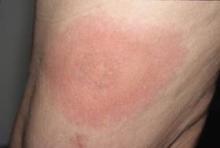Most cases of Lyme arthritis are brief and can be managed successfully with oral antibiotics, according to a recent review article in the February issue of the Journal of the American Academy of Orthopaedic Surgeons.
A delayed or missed diagnosis, however, increases the likelihood that the inflammatory response triggered by infection with the tick-borne Borrelia burgdorferi spirochete will lead to permanent joint damage, according to Dr. Brian G. Smith of Yale University in New Haven, Conn., and colleagues. For this reason, they stressed, Lyme arthritis "should be considered in the evaluation of patients with monoarticular or pauciarticular joint complaints in a geographic area in which Lyme disease is endemic."
Timely diagnosis of Lyme arthritis is often hampered by the fact that the clinical presentation – including recurrent episodes of joint swelling, typically in large joints such as the knee, but also possibly in the ankle, wrist, hip, or elbow; large effusions that may be out of proportion to patients' complaints; and, occasionally, fever – can be similar to that of inflammatory arthritides or acute bacterial septic arthritis, especially in children, the authors wrote (J. Am. Acad. Orthop. Surg. 2011.19:91-100).
In patients with acute symptoms, physicians "may be asked to evaluate a child who presents to the emergency department with an acutely swollen, tender joint as well as other Lyme disease–related symptoms that may be indicative of bacterial septic arthritis, such as malaise or irritability with or without fever and limited weight bearing." Joint-fluid analyses in patients with both diseases frequently reveal "strikingly elevated joint leukocyte counts," occasionally leading to unnecessary surgical joint debridement in patients erroneously diagnosed with septic arthritis, they stated.
Because of the similar and overlapping presentations and the fact that an accurate, reliable rapid test for Lyme disease is not widely available, "clinical and laboratory variables should be used as tools in the diagnostic armamentarium," the authors wrote. Although these variables have not been definitively established, the findings of a retrospective comparison of the clinical indications and laboratory results of children who presented to the emergency department with serologically confirmed Lyme arthritis and those who presented with septic arthritis identified a negative history of fever, knee involvement, and normal C-reactive protein (CRP) levels as important predictors of Lyme arthritis (Pediatrics. 2009; 123:959-65).
More recently, the authors of the current study conducted a review of children who presented to their institution with joint effusion, and determined that – relative to patients with septic arthritis – those with Lyme arthritis "had a lower average peripheral white blood count, lower percentage of neutrophils in the differential, were less likely to present with a temperature [greater than] 101.5[° F], and were less likely to refuse to bear weight on the affected extremity," they wrote. "No statistically significant difference existed between the two groups with regard to erythrocyte sedimentation rate and CRP level" (J. Bone Joint Surg. Am. 2011;93:252-60).
Following an accurate diagnosis, "Lyme arthritis has an excellent prognosis with appropriate management," the authors stressed. In adults without neurologic involvement, this includes a 28-day course of 100-mg doxycycline twice daily, 500-mg amoxicillin three times daily, or 500-mg cefuroxime axetil twice daily. The recommended treatment for children is a 28-day course of 50-mg/kg amoxicillin divided into three doses daily, 30-mg/kg cefuroxime axetil divided into two doses daily, or – for patients aged 8 years or older – 4-mg/kg doxycycline divided into two doses daily, they wrote.
Patients with mild persistent or recurrent synovitis after the initial therapeutic course should repeat the 28-day antibiotic course, whereas those with moderate to severe persistent arthritis should begin a 2-week or 4-week course of parenteral antibiotics, the authors wrote, noting that those with persistent symptoms after two treatment courses should undergo polymerase chain reaction (PCR) testing. Patients with positive PCR results should repeat the oral antibiotic regimen for 28 days, whereas those with negative PCR results may be treated with NSAIDs and intra-articular corticosteroids, they stated. Hydroxychloroquine, which may have antispirochetal and anti-inflammatory effects, may be used in the negative PCR patients, and "there may be a role for certain disease-modifying antirheumatic agents in the management of chronic Lyme arthritis, but experience with their use in this setting is limited," they said.

